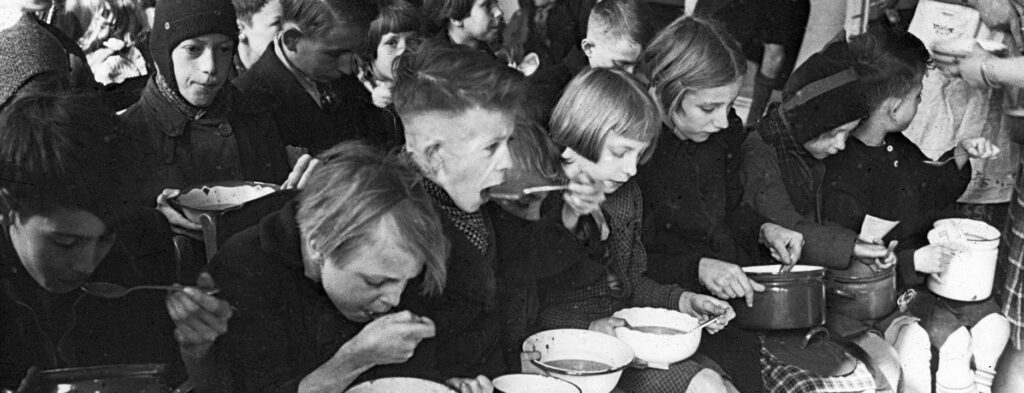We tend to think that ageing starts somewhere in late middle age. Who has not scrutinised their own reflection for signs of grey hair or the first wrinkle? But the reality is far more complex than that. Your chances of enjoying longevity starts with your grandparents.
During WWII the Germans invaded the Low Countries, precipitating an underground resistance that became more and more active as D Day arrived and the Allies started to re-take villages and towns up and down the North Sea Coast. In September 1944, Dutch railway workers went on strike, trying to stop the transport of German troops through their country, hoping to help the Allies northern approach from Normandy. The advance failed and the Nazis punished the Netherlands by blocking food supplies. This caused a terrible famine that coincided with a very cold winter, killing over 20,000 people, and having a massive and lasting impact on those who survived. The Dutch call it the Hunger Winter.
The Hongerwinter plunged people into a dreadful situation. Food rations were reduced, almost overnight, to about 900 calories per day. That is approximately half, to a third of an average person’s normal diet. After six months, the blockade was broken, and food rations rapidly increased again.
It is of course highly unethical to conduct starvation studies. The only way we get to lean about the effects of such privation, is after they have happened, when we can look back and try and understand the retrospective effects on a population. Fortunately, Dutch health records for the period remained excellent. The Hongerwinter, because it was neither predicted, nor too prolonged, gives us an opportunity to consider the effects on women who happened to be pregnant just at that time. While the event took place in the forties, the studies took place many years later. Scientists looked at the children of women who were pregnant during the starvation. They were able to compare these people with their siblings who had been born before or after the famine. The studies revealed how environmental factors, such as lack of food, can change the DNA we pass onto our children and even our grandchildren. They also provide some clues as to why putting on weight is so easy for most of us, yet losing it so difficult.
We all know that we inherit traits from our parents, such as the colour of our eyes and hair, but we assume those inherited characteristics are immutable. Our DNA never changes. However, DNA is merely the template for the body. As a foetus grows in the womb, the DNA provides the script for every aspect of our body and the programming for the thousands of bodily processes that allow us to thrive. Whether a process occurs and to what extent is occurs, relates to gene expression or epigenetics. Our environment can determine whether a particular part of our genetic code is switched-on, or lies dormant. These environmentally induced changes occur because of DNA methylation. In this process a methyl atom (a hydro-carbon) attaches to the DNA making transcription (replication) impossible. This process is essential in normal development. For example, DNA methylation helps to supress one set of the X chromosomes in females, so that they do not dangerously interfere with each other. But the Dutch scientists discovered that epigenetic changes were also imprinting on the future of children born after the famine ended. In addition, they discovered that the greatest, most heritable impacts, occurred during the first three months of gestation.
Sixty-eight years later, one study showed that children who had been in the womb during the famine had a ten percent increase in mortality compared with their younger or older siblings. Further studies have shown that this in-utero starvation has an effect on grandchildren as well as the children themselves. Their DNA was changed as a result of the early effects of starvation[i].
We have known for some time that those people whose bodies are better at storing fat, survive famine more easily. The study of babies exposed to the Dutch Hongerwinter revealed changes in their DNA that made them less vulnerable to famine. They were born at a normal weight. But sadly, during their lives these people displayed obesity in middle age and were more vulnerable to metabolic diseases in later life, such as dyslipidaemia (high fat levels) and type 2 diabetes.
The theory is that we all grow fat so easily because it is genetically preferential to be safe during a famine, than it is to get a bit fatter in times of plenty. Throughout human evolution, people who have been able to store fat well, were perhaps genetically favoured. What we didn’t know, until people started to study the offspring of Dutch famine survivors, is that the genetic advantage can be switched-on in the foetus and endure throughout life. More recent studies have shown that these fat-storing genetic traits can even influence the next generation, the grandchildren of men and women who experienced the Hongerwinter[ii]. Some studies have even suggested that great-grandchildren have been affected [iii].
DNA is derived from the parents’ germline cells. These cells are contained in the maternal egg and paternal sperm. During gestation these cells divide and mutate again and again, as the foetus develops. Both egg and sperm cells are made during the parents’ gestation, when they were in the womb. When a baby is born all the egg or sperm cells they will ever possess have already been made, though they continue to mature throughout childhood. The expression of DNA is thus very dependent upon the situation in which our parents and even our grandparents found themselves. How resilient we are was dictated, at least in part, years before we ourselves were born and is to some extent, independent of our genetic makeup. Our resilience has a direct relationship to the health of our grandparents and the stresses they had to bear in their youth. [iv]
Similarly, our own health is hugely impacted by the course of our own lives, our environment, whether we use or abuse our bodies and whether life uses or abuses us. It is easy to dismiss fad diets, so beloved of young people, as a relatively undamaging youthful conceit. The diet may not damage the young person particularly badly, they will have many years to recover. But such a diet (of the mother or the father) could impact a foetus, perhaps growing unknown inside the womb.
As we realise that genetics are not like a fixed hand of cards, but instead a toolkit that can be used or abused throughout life, the more important it becomes to look after ourselves. None of us are trapped by a bad set of genes. Perhaps this knowledge can make us a little more positive about our ability to make the best of life. Environment matters.
[i] Elmar W. Tobi et al, 2018 DNA methylation as a mediator of the association between prenatal adversity and risk factors for metabolic disease in adulthood. Science Advances 31 Jan 2018: EAAO4364
[ii] Painter RC, et al. Transgenerational effects of prenatal exposure to the Dutch famine on neonatal adiposity and health in later life. BJOG. 2008;115:1243–1249. doi: 10.1111/j.1471-0528.2008.01822.x.
[iii] Aiken CE, et al. 2016 Transgenerational effects of maternal diet on metabolic and reproductive ageing. Mammalian Genome. 2016;27(7-8):430-439. doi:10.1007/s00335-016-9631-1
[iv] Skinner MK, 2008 What is an epigenetic transgenerational phenotype? F3 or F2. Reproductive Toxicology. 2008 Jan; 25(1):2-6.
This year I shall be maintaining a weekly blog, covering pre-publication excerpts from the book as well as a series of articles about the science and the scientists who have unlocked the secrets of longevity. Please register your interest by clicking on the mailing list below.
A beta reader is a test reader of an unreleased work (similar to beta testing in software), who gives feedback to the author, from the perspective of an average reader. If you’d like to help me get this book as good as it can be, I’d love to hear from you. The chapters will be ready from June onwards. I’m sorry there is no fee for this work, except a free copy of the finished book and an acknowledgement. This is not a commercial exercise. Say Tomato, the publisher of the book and of the website is run as a self-financed social enterprise. I shall be eternally grateful. Any profits from Glorious Summer will be directed into Say Tomato work for women over 40.
Contact me directly wendy@wendyshillam.co.uk if you are interested, giving a brief description of yourself and your reading experience. (It doesn’t matter if you haven’t done any beta reading before – avid readers make the best beta readers.) Thank you.


Wendy Shillam
Trained in environmental and bio-sciences, Wendy Shillam is a registered clinical nutritionist, specialising in longevity. She is the founder of the social enterprise Say Tomato! that provides free and trusted weight loss advice for women over forty. This part of the blog is a precursor to publication of her book, Glorious Summer – the secrets of longevity. You can read about it here.

Fascinating insight Wendy. We instinctively sense fad diets are suspect but not appreciating the extent the harm that might be done. We need to respect the biological entities we are rather than be led to believe we can subjugate our bodies by some harsh, unnatural regime, without imagining there could be far-reaching consequences.